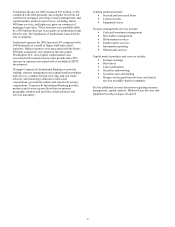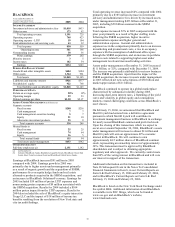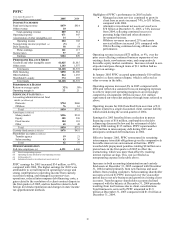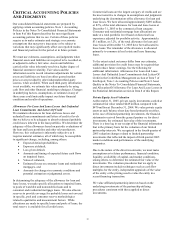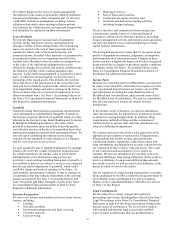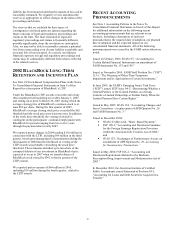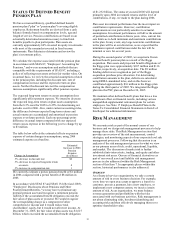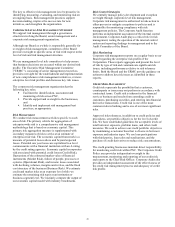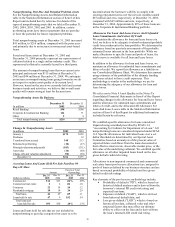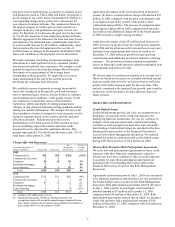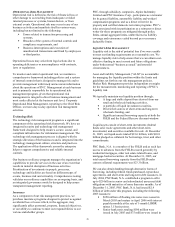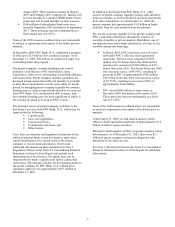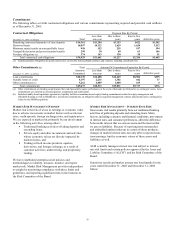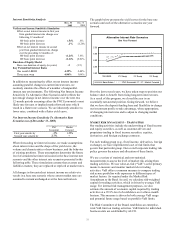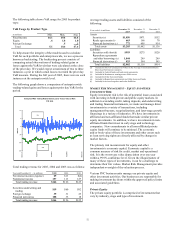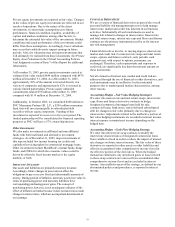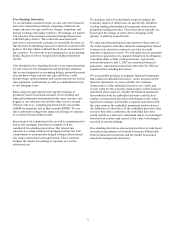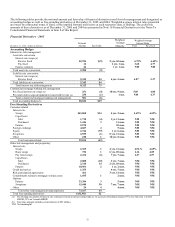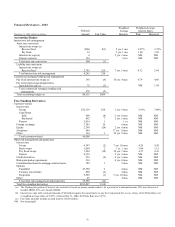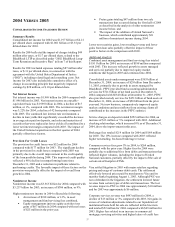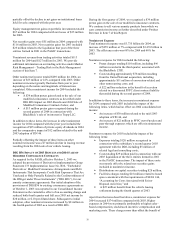PNC Bank 2005 Annual Report Download - page 48
Download and view the complete annual report
Please find page 48 of the 2005 PNC Bank annual report below. You can navigate through the pages in the report by either clicking on the pages listed below, or by using the keyword search tool below to find specific information within the annual report. 48
OPERATIONAL RISK MANAGEMENT
Operational risk is defined as the risk of financial loss or
other damage to us resulting from inadequate or failed
internal processes or systems, human factors, or from
external events. Operational risk may occur in any of our
business activities and manifests itself in various ways,
including but not limited to the following:
• Errors related to transaction processing and
systems,
• Breaches of the system of internal controls and
compliance requirements, and
• Business interruptions and execution of
unauthorized transactions and fraud by employees
or third parties.
Operational losses may arise from legal actions due to
operating deficiencies or noncompliance with contracts,
laws or regulations.
To monitor and control operational risk, we maintain a
comprehensive framework including policies and a system
of internal controls that is designed to manage risk and to
provide management with timely and accurate information
about the operations of PNC. Management at each business
unit is primarily responsible for its operational risk
management program, given that operational risk
management is integral to direct business management and
most easily effected at the business unit level. Corporate
Operational Risk Management, reporting to the Chief Risk
Officer, oversees day-to-day operation risk management
activities.
Technology Risk
The technology risk management program is a significant
component of the operational risk framework. We have an
integrated security and technology risk management
framework designed to help ensure a secure, sound, and
compliant infrastructure for information management. The
technology risk management process is aligned with the
strategic direction of the businesses and is integrated into the
technology management culture, structure and practices.
The application of this framework across the enterprise
helps to support comprehensive and reliable internal
controls.
Our business resiliency program manages the organization’ s
capabilities to provide services in the case of an event that
results in material disruption of business activities.
Prioritization of investments in people, processes,
technology and facilities are based on different types of
events, business risk and criticality. Comprehensive testing
validates our resiliency capabilities on an ongoing basis, and
an integrated governance model is designed to help assure
transparent management reporting.
Insurance
As a component of our risk management practices, we
purchase insurance programs designed to protect us against
accidental loss or losses which, in the aggregate, may
significantly affect personnel, property, financial objectives,
or our ability to continue to meet our responsibilities to our
various stakeholder groups.
PNC, through subsidiary companies, Alpine Indemnity
Limited and PNC Insurance Corp., participates as a reinsurer
for its general liability, automobile liability and workers’
compensation programs and as a direct writer for its
property and certified domestic terrorism programs. PNC’ s
risks associated with its participation as a reinsurer or direct
writer for these programs are mitigated through policy
limits, annual aggregate limits, umbrella/excess liability
coverage and reinsurance ceded beyond per occurrence
deductible limits.
LIQUIDITY RISK MANAGEMENT
Liquidity risk is the risk of potential loss if we were unable
to meet our funding requirements at a reasonable cost. We
manage liquidity risk to help ensure that we can obtain cost-
effective funding to meet current and future obligations
under both normal “business as usual” and stressful
circumstances.
Asset and Liability Management (“ALM”) is accountable
for managing the liquidity position within the limits and
guidelines set forth in our risk management policies.
Market Risk Management provides independent oversight
for the measurement, monitoring and reporting of PNC’ s
liquidity risk.
We typically maintain our liquidity position through:
• A large and stable deposit base derived from our
retail and wholesale banking activities,
• A portfolio of liquid investment securities,
• Diversified sources of short-term and long-term
wholesale funding, and
• Significant unused borrowing capacity at both the
FHLB and the Federal Reserve discount window.
Liquid assets consist of short-term investments (federal
funds sold, resale agreements and other short-term
investments) and securities available for sale. At December
31, 2005, our liquid assets totaled $23.6 b illion, with $10.8
billion pledged as collateral for borrowings, trust, and other
commitments.
PNC Bank, N.A. is a member of the FHLB and as such has
access to advances from the FHLB secured generally by
residential mortgages, other real estate related loans, and
mortgage-backed securities. At December 31, 2005, our
total unused borrowing capacity from the FHLB under
current collateral requirements was $23.3 billion.
We can also obtain funding through alternative forms of
borrowing, including federal funds purchased, repurchase
agreements, and short-term and long-term debt issuances. In
July 2004, PNC Bank, N.A. established a program to offer
up to $20 billion in senior and subordinated unsecured debt
obligations with maturities of more than nine months. As of
December 31, 2005, PNC Bank, N.A. had issued $2.4
billion of debt under this program, including the following
2005 issuances:
• $350 million of floating rate notes were issued in
March 2005 and mature in April 2006 with interest
payable monthly at the rate of 1-month LIBOR
minus 3.5 basis points.
• Senior bank notes totaling $500 million were
issued in July 2005 and $75 million were issued in


